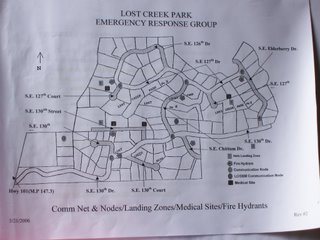

My day with the Lost Creek CERT team drill....
Saturday. CERT team members from Newport were invited to participate in a drill at the small community of Lost Creek south of Newport. Having heard many good things about their operation I was anxious to learn new techniques so we could bring them back to our area at Longview Hills a small community at the north end of Newport. It also makes good sense to go to other team member areas because we might ultimately be sent to work there in an emergency.
I was interested to find that this team had been organized and working on their own for about a year before CERT was introduced in the Newport Area. They then had about 6 folks sent to Newport for training. Then they incorporated what they had learned on their own into CERT procedures.
They had many things that our team had not even considered yet and so I was very grateful to be incorporated into their drill as a worker. This let me see from the ground up how their plan works. I was privy to team leader’s thoughts and the incident commander explained the many charts and the plans that were made because of them.
Lost Creek taught me a lot but I was caught up in the way they handled communications. As you all know we have FRS radios issued to us by the police department. Lost Hills started with this idea long ago. They have evolved it. Instead of just the CERT team having FRS radios they encourage their entire community of 95 homes to purchase one from Radio Shack for use in an emergency. They set one channel aside as the community information channel. During an emergency residents would tune to that channel for up to date information on what is happening and what they should do. That radio is kept at the communications center and was manned by a non CERT volunteer who did a terrific job on this her first drill. This lady also had radios that monitored the CERT operations that were going on (more later about this).
The Cert Teams (there were 3) which were in the assessment phase of finding what had happened in the neighborhood each had a separate radio frequency that they used. They explained this reduced cross talk between the neighborhood and the other teams. Team leaders Had 2 FRS radios. One tuned to the incident commander and the other to the individuals on their teams. These teams were not necessarily CERT members but members of the community under the supervision of a CERT team leader.
As a team member finished a group (or a cluster of home assessments) He/she notified their respective leader who picked them up in a car, tallied the numbers of red, black, green, and yellow SIRS (souls in residence) on a form and redeposited us at another cluster of homes to be checked. If the injured were badly hurt they were told that the responder would be back soon. If a home had uninjured they were enlisted to help those that were injured. The assessment continued until every home had been checked and the team leader would call the tallies into the communications center lady who in turn kept the incident commander informed as to the results.
All this time the Incident Commander was patrolling the community and making his assessment and directing the CERT team leaders where to complete their next assessments.
In 40 minutes all houses had been checked. All people had been assessed and a written record of all events had been made. Those residents who were home had the drill explained to them, were queeried about the number of people in home that day and asked how many normally were there. How many children, if they had enough of their critical meds to last 30 days if they had pets and how many. Then they were given a handout explaining what they should do to prepare for all kinds of emergencies.
Now, let’s go back a few paragraphs and talk about communications some more. We all remember the lady manning all the FRS radios and tallying the stats as they came in? There are two more communicators we have not heard from yet. Both of these folks were HAM amateur radio operators. They set up a radio transmitter and receiver complete with a portable antenna and were able to relay their status and needs to the entire county through a repeater station at Otter Rock. Their job was to radio this critical information collected to the county emergency center which they did with the greatest of ease. However, there was an extra bonus that was not planned.... The Coast Guard monitored and acknowledged that they had received all the data sent as did the RED Cross. Later the Radio operator said he would try out ways of hooking his equipment to a car battery to get away from a dependence on normal household power.
Not done with communications yet... The I/C asked owners of boats in the neighborhood with marine radios to man them thus giving the community an extra line of coverage.
Well, this is only some of what I learned and I can tell you I am anxious to show our team some of these ideas and see if we can’t adapt them to our community. The work was already done for us and maybe thanks to our fellow team members we can take a giant step forward.

No comments:
Post a Comment